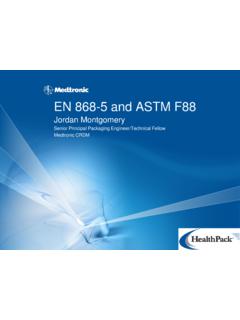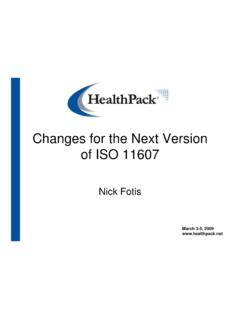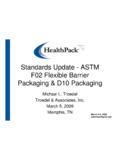Transcription of Case Study in Test Method Validation - ASTM …
1 1 March 3-5, Study in Test Method Validation - ASTM F1886 (2004), Visual ExaminationTodd Dehmer CPPS enior Packaging EngineerSt. Jude medical , AFD Division2 Presentation Overview Visual Inspection Usage ASTM F1886 Overview Reason for Validation Process for Validation On-going Validation3 Visual Inspection Usage Many medical Device Manufactures are referencing ASTM F1886 as the visual inspection Method they use to verify the sterile barrier integrity of their packaging. Are the MDM s referencing this Standard accurately? As specified per ASTM F1886: Should be validated to meet the precision and bias of ASTM F1886. Should be validated in accordance with AAMI/ANSI/ISO 11607-1:2006 and -2:2006?
2 Work within your own quality department to determine Per ISO 11607 Part 1: Test methods test methods used to show compliance with this part of ISO 11607 shall be validated and Annex B contains a list of suitable test methods (such as ASTM F1886). test Method Validation shalldemonstrate the suitability of the Method used. The following elements shallbe included: establishment of a rationale for the selection of the appropriate test for the packaging system; establishment of acceptance criteria;NOTE Pass/fail is a type of criteria; determination of test Method repeatability; determination of test Method reproducibility; and establishment of test Method sensitivity for integrity F1886 OverviewScope: To determine channels in a package seal down to a width of 75 m ( in.)
3 With a 60-100% probability. To visually detect channel defects applicable to flexible and rigid packages with at least one transparent F1886-04 OverviewSummary: To provide a qualitative visual inspection Method to evaluate the appearance characteristics of unopened, intact seals in order to determine the presence of defects that may affect the integrity of the F1886-04 OverviewSignificance and Use Seal attributes can be linked directly to a number of variables in process parameters, equipment, or material, as well as environmental. Visual seal characteristics and defects can provide evidence of sterile package integriy and production sealing F1886-04 OverviewLighting and Procedure Lighting arrangements to give approximately 540 lumens/m2 (50fc) of white light or daylight.
4 Visual acuity shall be such that the inspection of the seal may be performed at a distance of 12 to 18 F1886 OverviewPrecision and Bias A round robin Study was conducted for ASTM F 1886. The internal test Method should be shown to be equivalent to or better than ASTM F 1886 round robin results to differentiate acceptable package seals from specific types of F1886 OverviewPrecision and Bias - continued To accomplish this, samples with the same defect categories as those documented in the ASTM Method can be produced as well as a quantity of negative control samples with no channels. The defect categories used were (75 m) channel leaks and (125 m) channel would this Method be used?
5 As an internal Method to validate SBS sealing processes and new SBS configurations. As an internal Method to evaluate SBS after package performance testing. As a process monitoring/control tool. Evaluating seal integrity after an aging Study on an : ASTM F1886 is an FDA Recognized Consensus Standard12 Need for ValidationWhy is it necessary to validate this test? Requirement per ISO 11607 Current internal visual inspection Method may not have provided any formal training or attempt to validate. Provides better packaging for ValidationTest Prerequisites Acquire & diameter wire to create channel defects. Determine sample category to use for Validation (such as pouches or sealed trays).
6 Sample has to have one transparent side. Determine quantity of each sample category to use during Validation (this can be based on internal statistical requirements and significance).14 Process for ValidationTest Prerequisites - continued Have properly installed, calibrated, and maintained sealing equipment (bar sealers/tray sealers). Confirm lighting requirements are met per ASTM F1886 where the internal visual inspection of defects will be performed (measure via a light meter or similar device). Determine who will be assembling the samples. Determine who will be examining the for ValidationCreate a test Method Validation plan to include.
7 Plan information Plan approvals Test Method Data Validation Planning Validation Targets Sampling Plan Preparation Records Training, Examination and Data Collection Plan Analyze the data and prepare a Validation Report Approval Section16 Process for Validation Plan information Internal document number/identification/revision Plan approvals Author(s) of Validation Plan and others (such as quality representative) per your internal requirements Test Method Data Test Method description (Documented Visual Inspection procedure of pouch seals or tray seals) Test Method identification (ASTM F 1886)17 Process for Validation Validation Planning The scope/purpose of the Validation Description of what your trying to accomplish Validation Targets Repeatability Reproducibility Validation (target of what needs to be met to conform to ASTM F 1886)18 Process for Validation Sampling Plan Document quantity to be tested for each category ( , , & no defect negative controls)19 Process for Validation PreparationRecords Sample numbering (what labeling/marking Method to use to determine which samples have certain channel sizes and no defect samples) Equipment Equipment settings (process number and revision)
8 Environmental Conditions during assembly20 Process for Validation Preparation Records - continued Tooling (as required) Part and lot numbers of the SBS components used to assemble the samples Person(s) assembling the samples Date parts were assembled Person pre-judging the parts (if applicable/required)21 Process for Validation Training, Examination and Data Collection Plan Instruction provided to examiners (such as a review of ASTM F 1886) and existing internal visual inspection procedure Data Collection Plan Administering the examinations22 Process for Validation Analyze the data and prepare a Validation Report Organize and analyze the data collected from the examination Make determination of the Validation status based upon the data Document the results in a Validation Report including all applicable dataAfter a Validation Plan is complete its time to get for Validation Getting started follow thru with your Validation Document your equipment used (internal designation or otherwise, calibration date, etc.)
9 Confirm equipment settings meet internal manufacturing process requirements Document environmental conditions during assembly Tooling used Document part numbers, lot information, etc. Person(s) assembling the samples Date of assembly Person pre-judging the parts (if applicable)24 Process for Validation Getting started follow thru with your Validation - continued Document your Package Sample Defect & Identification Key25 Process for Validation Prepare samples per Validation plan Sample Preparation Randomly place the wire between the location to be sealed to create the defect (channel).26 Process for Validation Sample Preparation Example photo of how defect areas were for Validation Sample Preparation Follow your Identification Key and label sample appropriately.
10 Depending on your sample category (trays, pouches, etc) you will seal up samples for the , , and no Visual Examinations Perform visual examination (confirm adequate lighting per ASTM F 1886) When successfully completed it will provide evidence that an operator can perform the visual inspection and will be considered a validated the data Based on the results, the personnel who examined the samples should demonstrate the ability to repeat the results of the round robin Study done by ASTM30 Analyze the dataTrays Personnel who examined tray/lid samples should have identified 98% of no defects or better. Personnel who examined defects of the channels should have determined there to be defects 60% of the time.







